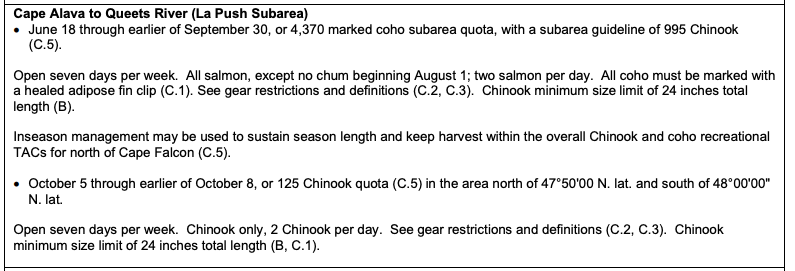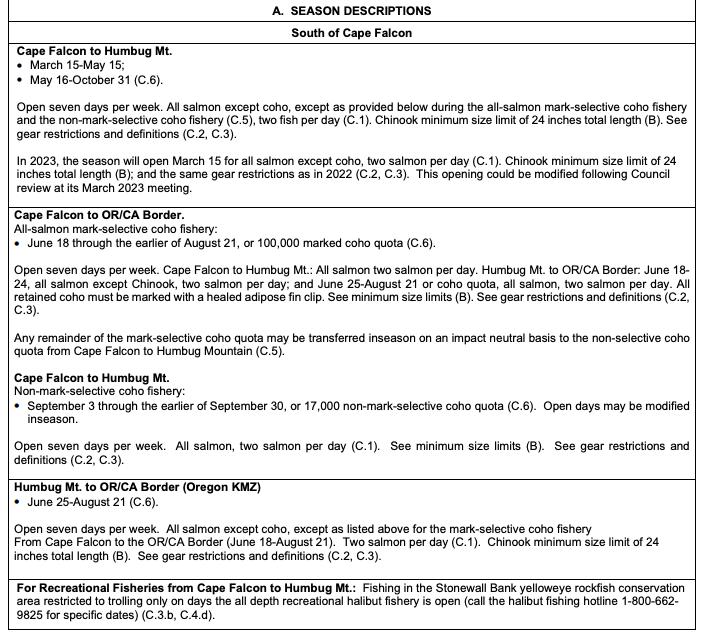
More Details On Ocean, Columbia, Sound King, Coho Seasons
This summer’s salmon season came into sharper focus this afternoon as ocean, Puget Sound and river managers came to agreements on 2022-23 recreational fisheries.
The big news is, thanks to a large expected Columbia River run, there’s a combined sport quota of 268,000 hatchery coho off Washington and Oregon, 78,000 more than last year and twice as many between Cape Falcon and Neah Bay as 2021, with seven-day-a-week fishing starting from June 18 to July 2, depending on the area.

But while a nice big catch of 55,000 clipped silvers is also expected at Buoy 10, Chinook fisheries there, on the coast and in Puget Sound are constrained and notably different than last year.
On the Columbia and Pacific, it’s tules – a type of fall Chinook native to the lower end of the big river – that are restricting fisheries. Washington’s ocean quota is 27,000, 250 fewer than 2021, and while Buoy 10 will open August 1, the first 24 days of the popular fishery will be for hatchery kings only before switching to any Chinook for two weeks.
On Puget Sound, where a new proposed 10-year management plan has been sent to the feds for approval but being implemented in the meanwhile, summer’s headliner Chinook fisheries – Areas 7, 9 and 10 – will all start slightly earlier than past years, July 14, but the San Juan Islands and Admiralty Inlet will be open in three-day, Thursday-Saturday bursts instead of daily fishing.

WDFW had been looking at opening Areas 7 and 9 as late as August 15 and August 1, when there would be lower impacts on Stillaguamish Chinook, a perennial constrainer, and to feather king fishing straight into coho season without the possibility of a break, but anglers insisted on July opportunity, when fishing is better in those waters for Chinook, and in a press release the agency’s Kyle Adicks acknowledged their voices had been heard, while also hinting at a new paradigm now in play.

Still, WDFW’s statewide salmon manager Mark Baltzell wasn’t sure that the concurrent openers would provide much opportunity past the first weekend in the San Juans, even if the the quota is 1,800, several hundred more than last year, when fishing was open for seven days before being shut down after high effort and catches. Longtime islands fishermen will recall days of yore when there was seven months of Chinook opportunity in the regs book.
Hatchery coho is then scheduled to open August 15 in the islands and run through September 30.
With a hatchery Chinook quota of 4,700, Baltzell thinks he’ll get a few more days out of Area 9, including July 21-23. Then, starting July 28, fishing would switch to seven days a week until the quota is exhausted. Afterwards, the waters will stay open for hatchery coho through September 25 – five days fewer than 2021.

That shaving is reflective of a “new paradigm” where coho fisheries may close earlier if too many Chinook are being caught and released, Baltzell said. That sort of close management has been largely limited to king seasons.
A provision under WDFW’s and the tribes’ new Puget Sound harvest management plan is the “conservation payback,” where fishery impacts across the board on Stillaguamish Chinook will also be evaluated the following January to see if they came in above or below expectations, and adjusting future fisheries to account for it. WDFW is ramping up its monitoring in both marine and freshwater areas to better track that.
“Chinook is the big constrainer, and will likely be for the next 10 years,” Baltzell says of the ESA-listed stock, “unless habitat issues and production increase.”
Another popular coho fishery, Area 8-2, was also shortened to August 13-September 19 and a reduced area will be in effect, meaning only the waters south of the Mukilteo-Clinton Ferry run to the Area 9 border will be open, meant to protect rebuilding Snohomish wild coho stocks. Only hatchery silvers will be retainable.
Baltzell characterizes most other inland saltwater fisheries as similar to last year, but notes that silvers will close two days earlier, September 28, on Areas 5 and 6, but will be open an extra week, till October 9, on Area 8-1, as a stronger run of Skagit fish begin to push through Deception Pass; hatchery Chinook retention will open June 1, two weeks earlier than last year, on Area 11, off Tacoma; and coho fishing will open June 16 on Area 10, off Seattle and Shoreline, where clipped kings will also be available July 14 through August 31, or until the quota of 3,966 is exhausted, with coho retention continuing afterwards.
Winter Chinook fisheries will be limited to Area 5 in March and April, though a similar season this year was closed early, Area 10 in February and March, Area 13, which is otherwise open year-round.

And Inner Elliott Bay will be open for at least one weekend, Friday, August 5, through noon Monday, August 8, with the potential for more, depending on a runsize update.

In terms of the rivers, Baltzell says there will be some extra closure days on the Nisqually in late August and early September to help meet objectives, while the Puyallup will also close at the end of September due to coho concerns.
With the Skokomish River ownership dispute unresolved, the south Hood Canal stream won’t be open for sport fishing, he said.

Down on the Lower Columbia, it’s a bit complex, given the situation with tules.
“It was the most constraining stock in the ocean and river fisheries,” said WDFW’s Ryan Lothrop, and that had advocates for both areas at odds.
Lothrop says the waters from Buoy 10 to the western end of Puget Island near Cathlamet will be open with a two-hatchery-salmon limit (only one Chinook) from August 1-24, then convert to any-king August 25-September 7. Chinook drop out of the bag but the limit bumps to three hatchery coho a day starting September 8 through the rest of the month before kings reopen in October.
From the west end of Puget Island to Warrior Rock, season runs August 1-September 7 for two salmon (hatchery coho only, only one Chinook) before closing for the rest of September for all salmonids, then reopening October 1 with the same bag as in August and early September.
From Warrior to Bonneville Dam, season runs August 1-September 13 with a daily limit of two salmon (hatchery coho only, only one Chinook), then closes for the rest of September.
Lothrop said Lower Columbia fisheries have been producing “more costly” impacts on tules in recent years, and he added that poor summer steelhead returns are adding “another layer” of constraints.
He added that there will be a “very limited” fishery for summer Chinook from the Astoria-Megler Bridge to Bonneville, running June 16-22 for up to two hatchery kings. On the river above the dam to Tri-Cities, season will run June 16 through July. Sockeye retention will be a no-go in both stretches.

Out on the Pacific, on the waters from the US-Canada border to Cape Alava, the Neah Bay fishery, salmon season opens seven days a week June 18 with a subquota of 17,470 hatchery coho and subguideline of 6,100 Chinook.

It’s the same start date and seven-day-a-week fishery off La Push, where the subquota and subguideline figures are 4,370 and 995.

Fishing opens about two weeks later, July 2, out of Westport, where the hatchery coho mark is 62,160, the Chinook subguideline is 12,070, and the water is open every day.

And off Ilwaco and the Oregon Coast north of Cape Falcon, season begins June 25 with a hatchery coho subquota of 84,000 and subguideline of 7,700 Chinook.

The coho goodness continues on Oregon’s Central and South Coasts, where there are 100,000 clipped silvers to catch, albeit 20,000 fewer than 2021, with fishing beginning June 18 and running daily through August 21, if the quota holds out that long. Chinook runs concurrently and runs through October, except begins June 25 from Humbug Mountain to the California border – the Oregon Klamath Management Zone – and goes through much of August.

The Central Coast then reopens September 3-30 for 17,000 unmarked silvers, up from 14,000 in 2021.
Where last year’s final day of the annual salmon-season-setting process went deep into the evening when Grays Harbor coho produced an unexpectedly large stumbling block, this year’s wrapped up with a relatively tame series of motions, seconds and unanimous votes as the Pacific Fisheries Management Council approved fisheries off Washington, Oregon and California.
“It helps when there’s high abundance and less to fight about,” noted WDFW’s Baltzell.
In an unusual though positive-for-fisheries move last Friday morning, the Washington Fish and Wildlife Commission waived a Grays Harbor salmon management provision for this season “that would otherwise limit opportunity given the strong forecasted coho run size.”
The 2022-23 set of Northwest salmon seasons are considered tentative until approved by the National Marine Fisheries Service.
Washington anglers fed up with North of Falcon will scoff, but Baltzell said there had been good public engagement this year and he felt like he and his fellow staffers had answered a lot of questions and detailed the challenges the fisheries face.
Baltzell hoped to return to in-person meetings next year but said elements of the hybrid Zoom approach would likely continue.
Editor’s note, 10:59 a.m., April 13, 2022: The initial version of this blog, posted the evening of April 12, 2022, has been updated with further context and graphics, as well as corrections.

